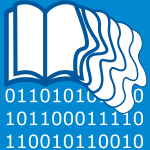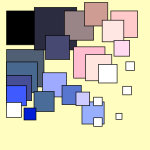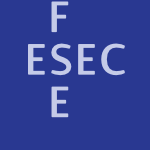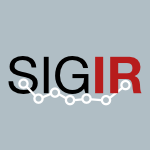Tag #eye tracking
76 papers:
 ICSME-2019-Guarnera #source code
ICSME-2019-Guarnera #source code- Enhancing Eye Tracking of Source Code: A Specialized Fixation Filter for Source Code (DTG), pp. 615–618.
 JCDL-2018-JayarathnaS #bound #modelling
JCDL-2018-JayarathnaS #bound #modelling- Evaluating Saccade-Bounded Eye Movement Features for the User Modeling (SJ, SS), pp. 21–24.
 ICSME-2016-SharifM #named
ICSME-2016-SharifM #named- iTrace: Overcoming the Limitations of Short Code Examples in Eye Tracking Experiments (BS, JIM), p. 647.
 ICPC-2015-BusjahnBBCPSST #linear #order
ICPC-2015-BusjahnBBCPSST #linear #order- Eye movements in code reading: relaxing the linear order (TB, RB, AB, MEC, JHP, CS, BS, ST), pp. 255–265.
 ICPC-2015-JbaraF #empirical #how #using
ICPC-2015-JbaraF #empirical #how #using- How programmers read regular code: a controlled experiment using eye tracking (AJ, DGF), pp. 244–254.
 SCAM-2015-UddinGGR #comprehension #on the #using #visualisation
SCAM-2015-UddinGGR #comprehension #on the #using #visualisation- On the comprehension of code clone visualizations: A controlled study using eye tracking (MSU, VG, CG, CKR), pp. 161–170.
 CSCW-2015-ChengSMFHD #online #social
CSCW-2015-ChengSMFHD #online #social- Social Eye Tracking: Gaze Recall with Online Crowds (SC, ZS, XM, JLF, SEH, AKD), pp. 454–463.
 DHM-EH-2015-ShiomiNOTGH
DHM-EH-2015-ShiomiNOTGH - Influence of Proficiency on Eye Movement of the Surgeon for Laparoscopic Cholecystectomy (HS, MN, TO, YT, AG, HH), pp. 367–373.
 DHM-HM-2015-GotoLTYH #analysis
DHM-HM-2015-GotoLTYH #analysis- Analysis of Eye Movement of Caregiver Concerning on Transfer Operation (AG, ML, YT, TY, HH), pp. 58–65.
 DHM-HM-2015-SugimotoTNG #comparison #process
DHM-HM-2015-SugimotoTNG #comparison #process- Comparison of Eye Movement During the Polishing Process of Metallographic Sample Between Expert and Nonexpert (TS, YT, HN, AG), pp. 399–410.
 HCI-IT-2015-MurataM #analysis #using
HCI-IT-2015-MurataM #analysis #using- Nonlinear Dynamical Analysis of Eye Movement Characteristics Using Attractor Plot and First Lyapunov Exponent (AM, TM), pp. 78–85.
 HCI-UC-2015-GunerI #recognition
HCI-UC-2015-GunerI #recognition- The Effect of Banner Location on Banner Recognition in a Turkish Government Website: An Eye Tracking Study (HG, YI), pp. 65–72.
 HIMI-IKC-2015-SturreCVS #assessment #using
HIMI-IKC-2015-SturreCVS #assessment #using- Using Eye Movements to Test Assumptions of the Situation Present Assessment Method (LS, DC, KPLV, TZS), pp. 45–52.
 CIKM-2015-ChenZSW #approach #modelling #query #realtime #topic
CIKM-2015-ChenZSW #approach #modelling #query #realtime #topic- A Real-Time Eye Tracking Based Query Expansion Approach via Latent Topic Modeling (YC, PZ0, DS0, BW), pp. 1719–1722.
 ESEC-FSE-2015-Konopka #dependence #identification #navigation
ESEC-FSE-2015-Konopka #dependence #identification #navigation- Combining eye tracking with navigation paths for identification of cross-language code dependencies (MK), pp. 1057–1059.
 ESEC-FSE-2015-ShafferWWMFS #ide #named #re-engineering
ESEC-FSE-2015-ShafferWWMFS #ide #named #re-engineering- iTrace: enabling eye tracking on software artifacts within the IDE to support software engineering tasks (TRS, JLW, BMW, SCM, MF, BS), pp. 954–957.
 DUXU-TMT-2014-Schall #design #effectiveness #navigation
DUXU-TMT-2014-Schall #design #effectiveness #navigation- Eye Tracking Insights into Effective Navigation Design (AS), pp. 363–370.
 HIMI-AS-2014-KangSCL #case study
HIMI-AS-2014-KangSCL #case study- A Study of Drivers’ Blind Spot in Used of Eye Tracking (YYK, YCS, CCC, CLL), pp. 253–260.
 ICPR-2014-TavakoliYRHS #analysis #recognition
ICPR-2014-TavakoliYRHS #analysis #recognition- Emotional Valence Recognition, Analysis of Salience and Eye Movements (HRT, VY, ER, JH, NS), pp. 4666–4671.
 ICDAR-2013-KunzeKYK #documentation #image #mobile #retrieval #using #word
ICDAR-2013-KunzeKYK #documentation #image #mobile #retrieval #using #word- The Wordometer — Estimating the Number of Words Read Using Document Image Retrieval and Mobile Eye Tracking (KK, HK, KY, KK), pp. 25–29.
 ICDAR-2013-ToyamaDSK #artificial reality #documentation #retrieval #smarttech
ICDAR-2013-ToyamaDSK #artificial reality #documentation #retrieval #smarttech- Wearable Reading Assist System: Augmented Reality Document Combining Document Retrieval and Eye Tracking (TT, AD, WS, KK), pp. 30–34.
 TPDL-2013-KemmanKM #interface #using
TPDL-2013-KemmanKM #interface #using- Eye Tracking the Use of a Collapsible Facets Panel in a Search Interface (MK, MK, JM), pp. 405–408.
 CHI-2013-TockerCSC #visualisation
CHI-2013-TockerCSC #visualisation- Individual user characteristics and information visualization: connecting the dots through eye tracking (DT, CC, BS, GC), pp. 295–304.
 DUXU-CXC-2013-WangTKS #evaluation #performance #predict
DUXU-CXC-2013-WangTKS #evaluation #performance #predict- Banner Evaluation Predicted by Eye Tracking Performance and the Median Thinking Style (MYW, DLT, CTK, VCS), pp. 129–138.
 DUXU-PMT-2013-ChynalSS #data analysis #evaluation #usability #using
DUXU-PMT-2013-ChynalSS #data analysis #evaluation #usability #using- Remote Usability Evaluation Using Eye Tracking Enhanced with Intelligent Data Analysis (PC, JS, JMS), pp. 212–221.
 HCI-AMTE-2013-AkiyoshiT #estimation #framework #interface #learning #using
HCI-AMTE-2013-AkiyoshiT #estimation #framework #interface #learning #using- An Estimation Framework of a User Learning Curve on Web-Based Interface Using Eye Tracking Equipment (MA, HT), pp. 159–165.
 HCI-AS-2013-TakahashiISUSHO #biology #using
HCI-AS-2013-TakahashiISUSHO #biology #using- Proposal for Driver Distraction Indexes Using Biological Signals Including Eye Tracking (NT, SI, HS, SU, YS, KH, MO), pp. 647–653.
 HCI-IMT-2013-TawatsujiKM #case study #modelling #towards
HCI-IMT-2013-TawatsujiKM #case study #modelling #towards- Experimental Study Toward Modeling of the Uncanny Valley Based on Eye Movements on Human/Non-human Faces (YT, KK, TM), pp. 398–407.
 HIMI-D-2013-ShengLD #comprehension #using
HIMI-D-2013-ShengLD #comprehension #using- Eyes Don’t Lie: Understanding Users’ First Impressions on Websites Using Eye Tracking (HS, NSL, SD), pp. 635–641.
 HIMI-HSM-2013-MizutaniKSASUKSI #development #visual notation
HIMI-HSM-2013-MizutaniKSASUKSI #development #visual notation- Development of Screening Visual Field Test Application that Use Eye Movement (MM, KK, SS, TA, TS, MU, SK, MS, TI), pp. 291–300.
 OCSC-2013-AdnanHAT #analysis #behaviour #network #online #social
OCSC-2013-AdnanHAT #analysis #behaviour #network #online #social- Eye Tracking Analysis of User Behavior in Online Social Networks (WAWA, WNHH, NA, JT), pp. 113–119.
 ICPR-2012-DuongDNLDLS #detection #locality #robust #video
ICPR-2012-DuongDNLDLS #detection #locality #robust #video- Robust eye localization in video by combining eye detector and eye tracker (CND, TCPD, TDN, DDL, DAD, BHL, SS), pp. 242–245.
 CHI-2011-DugganP
CHI-2011-DugganP - Skim reading by satisficing: evidence from eye tracking (GBD, SJP), pp. 1141–1150.
 CHI-2011-EllingLJ #using
CHI-2011-EllingLJ #using- Retrospective think-aloud method: using eye movements as an extra cue for participants’ verbalizations (SE, LL, MdJ), pp. 1161–1170.
 CHI-2011-Freeman #protocol #usability #using
CHI-2011-Freeman #protocol #usability #using- Triggered think-aloud protocol: using eye tracking to improve usability test moderation (BF), pp. 1171–1174.
 CHI-2011-HillDAGM #experience #web
CHI-2011-HillDAGM #experience #web- Older web users’ eye movements: experience counts (RLH, AD, JLA, PG, LM), pp. 1151–1160.
 CSCW-2011-GergleC #collaboration #mobile #using #what
CSCW-2011-GergleC #collaboration #mobile #using #what- See what I’m saying?: using Dyadic Mobile Eye tracking to study collaborative reference (DG, ATC), pp. 435–444.
 DUXU-v2-2011-Yang #web
DUXU-v2-2011-Yang #web- Exploring Cultural Variation in Eye Movements on a Web Page between Americans and Koreans (CY), pp. 68–76.
 HCI-DDA-2011-DjamasbiST #behaviour #visual notation
HCI-DDA-2011-DjamasbiST #behaviour #visual notation- Visual Hierarchy and Viewing Behavior: An Eye Tracking Study (SD, MS, TT), pp. 331–340.
 ICPC-2010-SharifM #identifier
ICPC-2010-SharifM #identifier- An Eye Tracking Study on camelCase and under_score Identifier Styles (BS, JIM), pp. 196–205.
 ICSM-2010-SharifM #comprehension #design pattern #layout
ICSM-2010-SharifM #comprehension #design pattern #layout- An eye tracking study on the effects of layout in understanding the role of design patterns (BS, JIM), pp. 1–10.
 ICPR-2010-Tagawa #modelling #statistics #using
ICPR-2010-Tagawa #modelling #statistics #using- Depth Perception Model Based on Fixational Eye Movements Using Bayesian Statistical Inference (NT), pp. 1662–1665.
 CHI-2009-BuscherCM #predict #using #web #what
CHI-2009-BuscherCM #predict #using #web #what- What do you see when you’re surfing?: using eye tracking to predict salient regions of web pages (GB, EC, MRM), pp. 21–30.
 HCD-2009-Cinar #case study #usability #web
HCD-2009-Cinar #case study #usability #web- Eye Tracking Method to Compare the Usability of University Web Sites: A Case Study (MOÇ), pp. 671–678.
 HCI-NT-2009-AlacamD #representation #usability
HCI-NT-2009-AlacamD #representation #usability- A Usability Study of WebMaps with Eye Tracking Tool: The Effects of Iconic Representation of Information (ÖA, MD), pp. 12–21.
 HCI-NT-2009-KimBJ #student #visual notation
HCI-NT-2009-KimBJ #student #visual notation- Students’ Visual Perceptions of Virtual Lectures as Measured by Eye Tracking (YJK, JAB, BHJ), pp. 85–94.
 HCI-NT-2009-MatsudaUOM #analysis #multi
HCI-NT-2009-MatsudaUOM #analysis #multi- An Analysis of Eye Movements during Browsing Multiple Search Results Pages (YM, HU, MO, KiM), pp. 121–130.
 HCI-VAD-2009-DogusoyC #comprehension #learning #process
HCI-VAD-2009-DogusoyC #comprehension #learning #process- An Innovative Way of Understanding Learning Processes: Eye Tracking (BD, KÇ), pp. 94–100.
 IDGD-2009-PhukanR #usability #using
IDGD-2009-PhukanR #usability #using- Considerations for Using Eye Trackers during Usability Studies (AP, MR), pp. 301–307.
 SIGIR-2009-BuscherED #comparison #feedback
SIGIR-2009-BuscherED #comparison #feedback- Segment-level display time as implicit feedback: a comparison to eye tracking (GB, LvE, AD), pp. 67–74.
 CHI-2008-RatwaniMT #fault #predict #using
CHI-2008-RatwaniMT #fault #predict #using- Predicting postcompletion errors using eye movements (RMR, JMM, JGT), pp. 539–542.
 ICPC-2007-YusufKM #comprehension #diagrams #uml
ICPC-2007-YusufKM #comprehension #diagrams #uml- Assessing the Comprehension of UML Class Diagrams via Eye Tracking (SY, HHK, JIM), pp. 113–122.
 CHI-2007-GuanC #rank #web
CHI-2007-GuanC #rank #web- An eye tracking study of the effect of target rank on web search (ZG, EC), pp. 417–420.
 HCI-MIE-2007-BaranDC #approach #how #problem
HCI-MIE-2007-BaranDC #approach #how #problem- How Do Adults Solve Digital Tangram Problems? Analyzing Cognitive Strategies Through Eye Tracking Approach (BB, BD, KÇ), pp. 555–563.
 HCI-MIE-2007-ZhangM
HCI-MIE-2007-ZhangM - Evaluating Eye Tracking with ISO 9241 — Part 9 (XZ, ISM), pp. 779–788.
 HCI-MIE-2007-ZhouZ #metric
HCI-MIE-2007-ZhouZ #metric- Impact of Mental Rotation Strategy on Absolute Direction Judgments: Supplementing Conventional Measures with Eye Movement Data (RZ, KZ), pp. 789–798.
 HIMI-IIE-2007-NagamatsuKKS #development #using
HIMI-IIE-2007-NagamatsuKKS #development #using- Development of a Skill Acquisition Support System Using Expert’s Eye Movement (TN, YK, JK, HS), pp. 430–439.
 CHI-2006-GuanLCR
CHI-2006-GuanLCR - The validity of the stimulated retrospective think-aloud method as measured by eye tracking (ZG, SL, EC, JR), pp. 1253–1262.
 CHI-2005-SadasivanGGD #using
CHI-2005-SadasivanGGD #using- Use of eye movements as feedforward training for a synthetic aircraft inspection task (SS, JSG, AKG, ATD), pp. 141–149.
 SIGIR-2005-PuolamakiSSSK #collaboration #information retrieval
SIGIR-2005-PuolamakiSSSK #collaboration #information retrieval- Combining eye movements and collaborative filtering for proactive information retrieval (KP, JS, ES, JS, SK), pp. 146–153.
 ICPR-v3-2004-BagciAKC #markov #modelling #using
ICPR-v3-2004-BagciAKC #markov #modelling #using- Eye Tracking Using Markov Models (AMB, RA, AAK, EC), pp. 818–821.
 ICPR-v4-2004-GoniEVC #algorithm #detection #robust
ICPR-v4-2004-GoniEVC #algorithm #detection #robust- Robust Algorithm for Pupil-Glint Vector Detection in a Video-oculography Eyetracking System (SG, JE, AV, RC), pp. 941–944.
 CHI-2003-HornofH
CHI-2003-HornofH - Cognitive strategies and eye movements for searching hierarchical computer displays (AJH, TH), pp. 249–256.
 ICPR-v4-2002-ZhuJFL #information retrieval #realtime
ICPR-v4-2002-ZhuJFL #information retrieval #realtime- Combining Kalman Filtering and Mean Shift for Real Time Eye Tracking under Active IR Illumination (ZZ, QJ, KF, KL), p. 318–?.
 CHI-2000-TanriverdiJ
CHI-2000-TanriverdiJ - Interacting with eye movements in virtual environments (VT, RJKJ), pp. 265–272.
 CHI-1999-ByrneADM #visual notation
CHI-1999-ByrneADM #visual notation- Eye Tracking the Visual Search of Click-Down Menus (MDB, JRA, SD, MM), pp. 402–409.
 CHI-1999-Salvucci #interface #modelling #process
CHI-1999-Salvucci #interface #modelling #process- Inferring Intent in Eye-Based Interfaces: Tracing Eye Movements with Process Models (DDS), pp. 254–261.
 HCI-EI-1999-KohzukiNTUHT #interactive #using
HCI-EI-1999-KohzukiNTUHT #interactive #using- Man-Machine Interaction Using Eye Movement (KK, TN, AT, MU, SH, KT), pp. 407–411.
 HCI-EI-1999-Stelovsky #architecture #integration #interactive #java #source code #user interface
HCI-EI-1999-Stelovsky #architecture #integration #interactive #java #source code #user interface- An Extendible Architecture for the Integration of Eye Tracking and User Interaction Events of Java Programs with Complex User Interfaces (JS), pp. 861–865.
 HCI-EI-1999-TeiwesBEMST #human-computer #interactive #research #testing #usability #using
HCI-EI-1999-TeiwesBEMST #human-computer #interactive #research #testing #usability #using- The Use of Eye Tracking for Human-Computer Interaction Research and Usability Testing (WT, MB, GWE, SM, ES, WT), pp. 1119–1122.
 ICPR-1998-BernoggerYBP #animation
ICPR-1998-BernoggerYBP #animation- Eye tracking and animation for MPEG-4 coding (SB, LY, AB, AP), pp. 1281–1284.
 HCI-ACS-1993-PouraghabagherB #evaluation #monitoring #using
HCI-ACS-1993-PouraghabagherB #evaluation #monitoring #using- An Evaluation of Information Highlighting Methods on Computer Screens Using an Eye Movement Monitor (RP, DB), pp. 762–767.
 HCI-ACS-1993-SaitoSTSS
HCI-ACS-1993-SaitoSTSS - Characteristics of Vertical Eye Movements in the Workstation Used Flat Panel Display (SS, MS, ST, TS, SS), pp. 756–761.
 HCI-SHI-1993-MoriiKT #animation #detection #evaluation #realtime #using
HCI-SHI-1993-MoriiKT #animation #detection #evaluation #realtime #using- Evaluation of a Gaze Using Real-Time CG Eye-Animation Combined with Eye Movement Detector (KM, FK, NT), pp. 1103–1108.
 CHI-1990-Jacob #interactive #what
CHI-1990-Jacob #interactive #what- What you look at is what you get: eye movement-based interaction techniques (RJKJ), pp. 11–18.
 HCI-SES-1987-Saito #analysis #evaluation
HCI-SES-1987-Saito #analysis #evaluation- Quantitative Evaluation of VDT Operations Through the Analysis of Spatio-Temporal Characteristics of Eye Movement (SS), pp. 197–202.
 ICSME-2019-Guarnera #source code
ICSME-2019-Guarnera #source code JCDL-2018-JayarathnaS #bound #modelling
JCDL-2018-JayarathnaS #bound #modelling ICSME-2016-SharifM #named
ICSME-2016-SharifM #named ICPC-2015-BusjahnBBCPSST #linear #order
ICPC-2015-BusjahnBBCPSST #linear #order ICPC-2015-JbaraF #empirical #how #using
ICPC-2015-JbaraF #empirical #how #using SCAM-2015-UddinGGR #comprehension #on the #using #visualisation
SCAM-2015-UddinGGR #comprehension #on the #using #visualisation CSCW-2015-ChengSMFHD #online #social
CSCW-2015-ChengSMFHD #online #social DHM-EH-2015-ShiomiNOTGH
DHM-EH-2015-ShiomiNOTGH  DHM-HM-2015-GotoLTYH #analysis
DHM-HM-2015-GotoLTYH #analysis DHM-HM-2015-SugimotoTNG #comparison #process
DHM-HM-2015-SugimotoTNG #comparison #process HCI-IT-2015-MurataM #analysis #using
HCI-IT-2015-MurataM #analysis #using HCI-UC-2015-GunerI #recognition
HCI-UC-2015-GunerI #recognition HIMI-IKC-2015-SturreCVS #assessment #using
HIMI-IKC-2015-SturreCVS #assessment #using CIKM-2015-ChenZSW #approach #modelling #query #realtime #topic
CIKM-2015-ChenZSW #approach #modelling #query #realtime #topic ESEC-FSE-2015-Konopka #dependence #identification #navigation
ESEC-FSE-2015-Konopka #dependence #identification #navigation ESEC-FSE-2015-ShafferWWMFS #ide #named #re-engineering
ESEC-FSE-2015-ShafferWWMFS #ide #named #re-engineering DUXU-TMT-2014-Schall #design #effectiveness #navigation
DUXU-TMT-2014-Schall #design #effectiveness #navigation HIMI-AS-2014-KangSCL #case study
HIMI-AS-2014-KangSCL #case study ICPR-2014-TavakoliYRHS #analysis #recognition
ICPR-2014-TavakoliYRHS #analysis #recognition ICDAR-2013-KunzeKYK #documentation #image #mobile #retrieval #using #word
ICDAR-2013-KunzeKYK #documentation #image #mobile #retrieval #using #word ICDAR-2013-ToyamaDSK #artificial reality #documentation #retrieval #smarttech
ICDAR-2013-ToyamaDSK #artificial reality #documentation #retrieval #smarttech TPDL-2013-KemmanKM #interface #using
TPDL-2013-KemmanKM #interface #using CHI-2013-TockerCSC #visualisation
CHI-2013-TockerCSC #visualisation DUXU-CXC-2013-WangTKS #evaluation #performance #predict
DUXU-CXC-2013-WangTKS #evaluation #performance #predict DUXU-PMT-2013-ChynalSS #data analysis #evaluation #usability #using
DUXU-PMT-2013-ChynalSS #data analysis #evaluation #usability #using HCI-AMTE-2013-AkiyoshiT #estimation #framework #interface #learning #using
HCI-AMTE-2013-AkiyoshiT #estimation #framework #interface #learning #using HCI-AS-2013-TakahashiISUSHO #biology #using
HCI-AS-2013-TakahashiISUSHO #biology #using HCI-IMT-2013-TawatsujiKM #case study #modelling #towards
HCI-IMT-2013-TawatsujiKM #case study #modelling #towards HIMI-D-2013-ShengLD #comprehension #using
HIMI-D-2013-ShengLD #comprehension #using HIMI-HSM-2013-MizutaniKSASUKSI #development #visual notation
HIMI-HSM-2013-MizutaniKSASUKSI #development #visual notation OCSC-2013-AdnanHAT #analysis #behaviour #network #online #social
OCSC-2013-AdnanHAT #analysis #behaviour #network #online #social ICPR-2012-DuongDNLDLS #detection #locality #robust #video
ICPR-2012-DuongDNLDLS #detection #locality #robust #video CHI-2011-DugganP
CHI-2011-DugganP  CHI-2011-EllingLJ #using
CHI-2011-EllingLJ #using CHI-2011-Freeman #protocol #usability #using
CHI-2011-Freeman #protocol #usability #using CHI-2011-HillDAGM #experience #web
CHI-2011-HillDAGM #experience #web CSCW-2011-GergleC #collaboration #mobile #using #what
CSCW-2011-GergleC #collaboration #mobile #using #what DUXU-v2-2011-Yang #web
DUXU-v2-2011-Yang #web HCI-DDA-2011-DjamasbiST #behaviour #visual notation
HCI-DDA-2011-DjamasbiST #behaviour #visual notation ICPC-2010-SharifM #identifier
ICPC-2010-SharifM #identifier ICSM-2010-SharifM #comprehension #design pattern #layout
ICSM-2010-SharifM #comprehension #design pattern #layout ICPR-2010-Tagawa #modelling #statistics #using
ICPR-2010-Tagawa #modelling #statistics #using CHI-2009-BuscherCM #predict #using #web #what
CHI-2009-BuscherCM #predict #using #web #what HCD-2009-Cinar #case study #usability #web
HCD-2009-Cinar #case study #usability #web HCI-NT-2009-AlacamD #representation #usability
HCI-NT-2009-AlacamD #representation #usability HCI-NT-2009-KimBJ #student #visual notation
HCI-NT-2009-KimBJ #student #visual notation HCI-NT-2009-MatsudaUOM #analysis #multi
HCI-NT-2009-MatsudaUOM #analysis #multi HCI-VAD-2009-DogusoyC #comprehension #learning #process
HCI-VAD-2009-DogusoyC #comprehension #learning #process IDGD-2009-PhukanR #usability #using
IDGD-2009-PhukanR #usability #using SIGIR-2009-BuscherED #comparison #feedback
SIGIR-2009-BuscherED #comparison #feedback CHI-2008-RatwaniMT #fault #predict #using
CHI-2008-RatwaniMT #fault #predict #using ICPC-2007-YusufKM #comprehension #diagrams #uml
ICPC-2007-YusufKM #comprehension #diagrams #uml CHI-2007-GuanC #rank #web
CHI-2007-GuanC #rank #web HCI-MIE-2007-BaranDC #approach #how #problem
HCI-MIE-2007-BaranDC #approach #how #problem HCI-MIE-2007-ZhangM
HCI-MIE-2007-ZhangM  HCI-MIE-2007-ZhouZ #metric
HCI-MIE-2007-ZhouZ #metric HIMI-IIE-2007-NagamatsuKKS #development #using
HIMI-IIE-2007-NagamatsuKKS #development #using CHI-2006-GuanLCR
CHI-2006-GuanLCR  CHI-2005-SadasivanGGD #using
CHI-2005-SadasivanGGD #using SIGIR-2005-PuolamakiSSSK #collaboration #information retrieval
SIGIR-2005-PuolamakiSSSK #collaboration #information retrieval ICPR-v3-2004-BagciAKC #markov #modelling #using
ICPR-v3-2004-BagciAKC #markov #modelling #using ICPR-v4-2004-GoniEVC #algorithm #detection #robust
ICPR-v4-2004-GoniEVC #algorithm #detection #robust CHI-2003-HornofH
CHI-2003-HornofH  ICPR-v4-2002-ZhuJFL #information retrieval #realtime
ICPR-v4-2002-ZhuJFL #information retrieval #realtime CHI-2000-TanriverdiJ
CHI-2000-TanriverdiJ  CHI-1999-ByrneADM #visual notation
CHI-1999-ByrneADM #visual notation CHI-1999-Salvucci #interface #modelling #process
CHI-1999-Salvucci #interface #modelling #process HCI-EI-1999-KohzukiNTUHT #interactive #using
HCI-EI-1999-KohzukiNTUHT #interactive #using HCI-EI-1999-Stelovsky #architecture #integration #interactive #java #source code #user interface
HCI-EI-1999-Stelovsky #architecture #integration #interactive #java #source code #user interface HCI-EI-1999-TeiwesBEMST #human-computer #interactive #research #testing #usability #using
HCI-EI-1999-TeiwesBEMST #human-computer #interactive #research #testing #usability #using ICPR-1998-BernoggerYBP #animation
ICPR-1998-BernoggerYBP #animation HCI-ACS-1993-PouraghabagherB #evaluation #monitoring #using
HCI-ACS-1993-PouraghabagherB #evaluation #monitoring #using HCI-ACS-1993-SaitoSTSS
HCI-ACS-1993-SaitoSTSS  HCI-SHI-1993-MoriiKT #animation #detection #evaluation #realtime #using
HCI-SHI-1993-MoriiKT #animation #detection #evaluation #realtime #using CHI-1990-Jacob #interactive #what
CHI-1990-Jacob #interactive #what HCI-SES-1987-Saito #analysis #evaluation
HCI-SES-1987-Saito #analysis #evaluation











